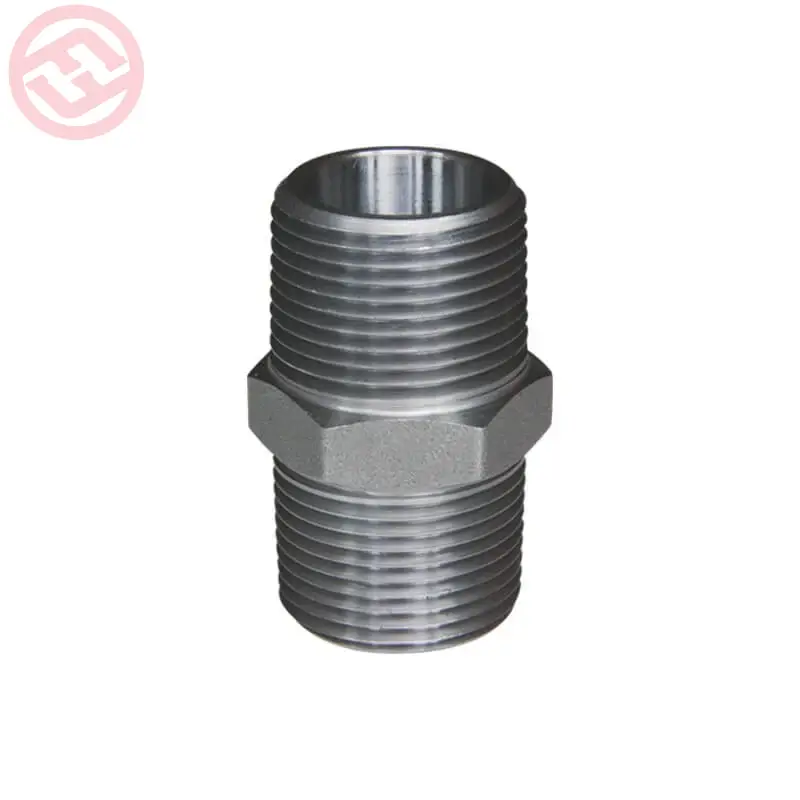Selecting the right type and size of steel nipple for a specific project involves considering several factors.
Here are some key considerations:
- Material: Determine the appropriate material for the steel nipple based on the requirements of the project. Common materials include carbon steel, stainless steel, and alloy steel. Consider factors such as corrosion resistance, strength, and compatibility with the fluid or gas being conveyed.
- Size: Determine the correct size of the steel nipple based on the pipe size and the application requirements. Consider the inner diameter (ID) and outer diameter (OD) of the pipe, as well as the required flow rate and pressure. Standard pipe sizes are defined by nominal pipe size (NPS) or pipe schedule, so ensure that the steel nipple matches the corresponding size.
- Thread type: Consider the type of threads required for proper connection. Common thread types include NPT (National Pipe Thread), BSPT (British Standard Pipe Taper), and BSP (British Standard Pipe Parallel). Ensure that the steel nipple has the appropriate thread type and size to match the connecting pipes or fittings.
- Length: Determine the required length of the steel nipple based on the specific installation requirements. Consider factors such as the distance between pipes, clearance for installation, and alignment of fittings. Steel nipples are available in various lengths, including close nipple (shortest length), standard nipple, and long/extra-long nipple.
- End connections: Determine the appropriate end connections for the steel nipple. Common options include threaded ends for screwing into fittings or pipes, and plain ends for welding or brazing. Consider the compatibility of the end connections with the existing piping system or the desired method of connection.
- Application and environment: Consider the specific application and environment where the steel nipple will be used. Factors such as temperature, pressure, fluid or gas characteristics, and environmental conditions (corrosive, high-temperature, etc.) should be taken into account. Ensure that the selected steel nipple is suitable for the intended application and can withstand the operating conditions.
- Compliance with standards: Verify that the selected steel nipple complies with relevant industry standards and codes, such as ASTM, ASME, or specific regulatory requirements that may apply to your project. Compliance ensures the quality, Steel Nipple performance, and safety of the steel nipple.
It is recommended to consult with engineers, piping designers, or industry experts to ensure the selection of the appropriate type and size of steel nipple for your specific project. They can provide valuable guidance based on their expertise and knowledge of applicable standards and best practices.
How are steel nipples different from other types of pipe fittings?
Steel nipples are a specific type of pipe fitting that serve as a short length of pipe with male threads at both ends.
Here are some ways in which steel nipples differ from other types of pipe fittings:
- Length: Steel nipples are typically shorter in length compared to other pipe fittings, such as elbows, tees, or couplings. They are designed to provide a short extension or connection between two pipes or fittings.
- Threaded Connections: Steel nipples have male threads at both ends, which allow them to be screwed into corresponding female threaded fittings or pipes. This threaded connection provides a secure and leak-resistant joint.
- Versatility: Steel nipples are highly versatile and can be used in a wide range of applications. They can be used to extend pipe lengths, connect different pipe sections, or adapt pipe sizes. Steel nipples are available in various lengths, sizes, and thread types to accommodate different requirements.
- Simplicity: Steel nipples are relatively simple in design, consisting of a straight pipe with threaded ends. This simplicity makes them easy to install and connect, requiring minimal tools and equipment.
- Connection Methods: Unlike some other pipe fittings that may require welding, brazing, or flaring, steel nipples are typically connected using threaded connections. This allows for easier installation and disassembly, making them suitable for applications where frequent changes or modifications are required.
- Applications: Steel nipples find application in various industries and systems, including plumbing, HVAC (Heating, Ventilation, and Air Conditioning), industrial piping, and process piping. They are commonly used for fluid or gas transfer, distribution, or redirection within a piping system.
It’s important to note that while steel nipples have specific characteristics and applications, they are often used in conjunction with other types of pipe fittings to create complex piping configurations. The selection of the appropriate pipe fittings depends on the specific requirements of the system and the desired functionality of the overall piping layout.
